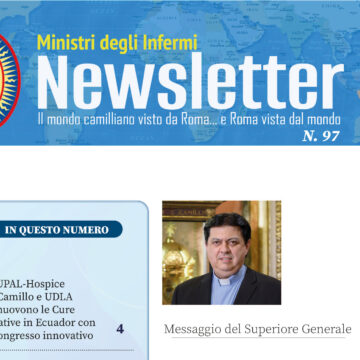 As a part of its set of remedies, palliative care uses a series of supplementary therapies whose goal is the wellbeing of the patient. These support classic therapeutic methods and involve volunteers and family relatives, making them feel, in the accompanying of a terminally-ill person, that they are playing a leading role.
As a part of its set of remedies, palliative care uses a series of supplementary therapies whose goal is the wellbeing of the patient. These support classic therapeutic methods and involve volunteers and family relatives, making them feel, in the accompanying of a terminally-ill person, that they are playing a leading role.
The nurturing touch is one of these initiatives and it is increasingly a part of the services offered to relieve the pain of patients.
Already used in various Italian hospices, it is also being introduced in the ‘Luigi Tezza’ Hospice of the Fondazione Opera San Camillo in Capriate (BG). It can be understood only within a concept of care which has the comfort of the patient as its goal. According to the Grande Dizionario Italiano, comfort is a ‘complex of elements which make daily life in a given environment easy and pleasant’, a condition that is about how an individual feels and one that can be achieved by any means.
It is within this line of thinking that one can understand the role and the dignity of the nurturing touch which helps to achieve a pleasant situation without undermining the dignity of other initiatives of health-care professionals that have been scientifically proved to be effective.
It is rightly placed amongst the therapies that find space within palliative care, helping to improve the quality of life of patients and their loved ones.
What is the nurturing touch?
The nurturing touch is a special massage technique that is characterised by light pressure, stroking, circular movements and hugs that allow the release of endorphins, the hormones that produce a feeling of wellbeing and absence of pain. This massage can be applied to various parts of the body although those that are most frequently chosen are the feet, the arms, the hands, the back and the legs. In particular, the presence in the palm of the hand and the sole of the feet of many sensorial receptors makes them preferred to other areas, allowing ‘communication’ even in total silence! For the massage to achieve its aims, the masseur must be calm and tranquil, secure and concentrating, and avoid giving the impression that he or she is engaging in one of the very many activities of his or her extensive programme of work. Indeed, the massage must be carried out in an atmosphere of peace, relaxation and kindness, fully respecting the dignity and the privacy of the patient.
The nurturing touch is not invasive and there are few areas where it should not be used, such as a rocking hug in patients with nausea, dizziness or disorientation, or circular movements that go against the bone and muscle structure. It can be taught to anybody and it is a tool that is especially useful for nurses who more than anyone else are in direct contact with patients.
The Benefits of the Nurturing Touch
Scientific research into the nurturing touch has been expanding and has come to support its validity. It has various benefits. At a physical level, it reduces tension and relaxes contracted muscles following breastfeeding, improving the circulation of the blood and the working of lymph glands and reducing pain. Its function of improving constipation, one of the problems that most afflicts patients at the terminal stage of their illness who are being treated with painkillers, should not be underestimated. At a psychological level, this form of massage communicates acceptance and care and helps to modify mood, fostering closer communication between the patient and those taking care of him or her. From a spiritual point of view, it communicates presence and alleviates the feeling of fear and loneliness into which the patient has fallen.
 In creating an atmosphere of peace and serenity, it allows an exploration of the meaning of the patient’s life at a time when it seems to have ceased to have one. In addition, used during the terminal stage of an illness, it fosters and enriches the relationships that the patient has with his or her loved ones through the modality of their being at his or her side with ‘com-passion’. Lastly, we should not underestimate the role that it plays in fostering a positive relationship between the patient and health-care workers who thereby acquire new skills that are able to renew their motivation and prevent the syndrome of burnout.
In creating an atmosphere of peace and serenity, it allows an exploration of the meaning of the patient’s life at a time when it seems to have ceased to have one. In addition, used during the terminal stage of an illness, it fosters and enriches the relationships that the patient has with his or her loved ones through the modality of their being at his or her side with ‘com-passion’. Lastly, we should not underestimate the role that it plays in fostering a positive relationship between the patient and health-care workers who thereby acquire new skills that are able to renew their motivation and prevent the syndrome of burnout.
Conclusion
From what has been said, it appears evident that the nurturing touch allows the patient to attain the objective of tranquillity, wellbeing and relief: scientific research offers increasing data to support this evidence.
In particular, the nurturing touch has a positive impact on comfort without producing damage or lesions in the patient. Valid during every season of life, it is this to the greatest extent during a season of illness because it meets needs that are often underestimated and marginalised in favour of a technological and ascetic approach. A nurse, more than any other figure, can benefit from this thinking, which becomes practice, because he or she usually lives in intimate contact with the patient.
Luca Perletti














Camillians on Facebook
Camillians on Twitter
Camillians on Instagram